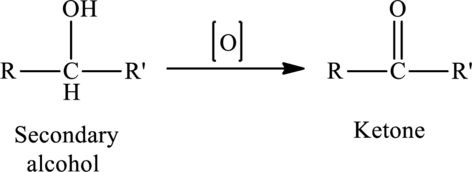
Concept explainers
(a)
Interpretation:
The structural formula of the product of the reaction of glycerol with stearic acid has to be drawn.
Concept Introduction:
Preparation of Esters:
Esters are prepared from the reaction of
The general preparation of esters is shown below,

Structural formula: Structural formulas identify the location of
(b)
Interpretation:
The structural formula of the product of the oxidation reaction of 4-hydroxybenzyl alcohol has to be drawn.
Concept Introduction:
The oxidation of a primary alcohol produces an aldehyde.
The generalized equation is written as,

The oxidation of a secondary alcohol produces a ketone.
The generalized equation is written as,

Structural formula: Structural formulas identify the location of chemical bonds between the atoms of a molecule. A structural formula consists of symbols for the atoms connected by short lines that represent chemical bonds-one, two or three standing lines for single, double or triple bonds respectively.
Want to see the full answer?
Check out a sample textbook solution
Chapter 11 Solutions
ACHIEVE/CHEMICAL PRINCIPLES ACCESS 1TERM
- Assign the functional group bands on the IR spectra.arrow_forwardFind the pH of a 0.120 M solution of HNO2. Find the pH ignoring activity effects (i.e., the normal way). Find the pH in a solution of 0.050 M NaCl, including activityarrow_forwardPlease help me answer these three questions. Required info should be in data table.arrow_forward
- Draw the major organic substitution product or products for (2R,3S)-2-bromo-3-methylpentane reacting with the given nucleophile. Clearly drawn the stereochemistry, including a wedged bond, a dashed bond and two in-plane bonds at each stereogenic center. Omit any byproducts. Bri CH3CH2O- (conc.) Draw the major organic product or products.arrow_forwardTartaric acid (C4H6O6) is a diprotic weak acid. A sample of 875 mg tartaric acid are dissolved in 100 mL water and titrated with 0.994 M NaOH. How many mL of NaOH are needed to reach the first equivalence point? How many mL of NaOH are needed to reach the second equivalence point?arrow_forwardIncluding activity, calculate the solubility of Pb(IO3)2 in a matrix of 0.020 M Mg(NO3)2.arrow_forward
- Order the following series of compounds from highest to lowest reactivity to electrophilic aromatic substitution, explaining your answer: 2-nitrophenol, p-Toluidine, N-(4-methylphenyl)acetamide, 4-methylbenzonitrile, 4-(trifluoromethyl)benzonitrile.arrow_forwardOrdene la siguiente serie de compuestos de mayor a menor reactividad a la sustitución aromática electrofílica, explicando su respuesta: ácido bencenosulfónico, fluorobenceno, etilbenceno, clorobenceno, terc-butilbenceno, acetofenona.arrow_forwardCan I please get all final concentrations please!arrow_forward
 Chemistry: Principles and ReactionsChemistryISBN:9781305079373Author:William L. Masterton, Cecile N. HurleyPublisher:Cengage Learning
Chemistry: Principles and ReactionsChemistryISBN:9781305079373Author:William L. Masterton, Cecile N. HurleyPublisher:Cengage Learning Chemistry: The Molecular ScienceChemistryISBN:9781285199047Author:John W. Moore, Conrad L. StanitskiPublisher:Cengage Learning
Chemistry: The Molecular ScienceChemistryISBN:9781285199047Author:John W. Moore, Conrad L. StanitskiPublisher:Cengage Learning

